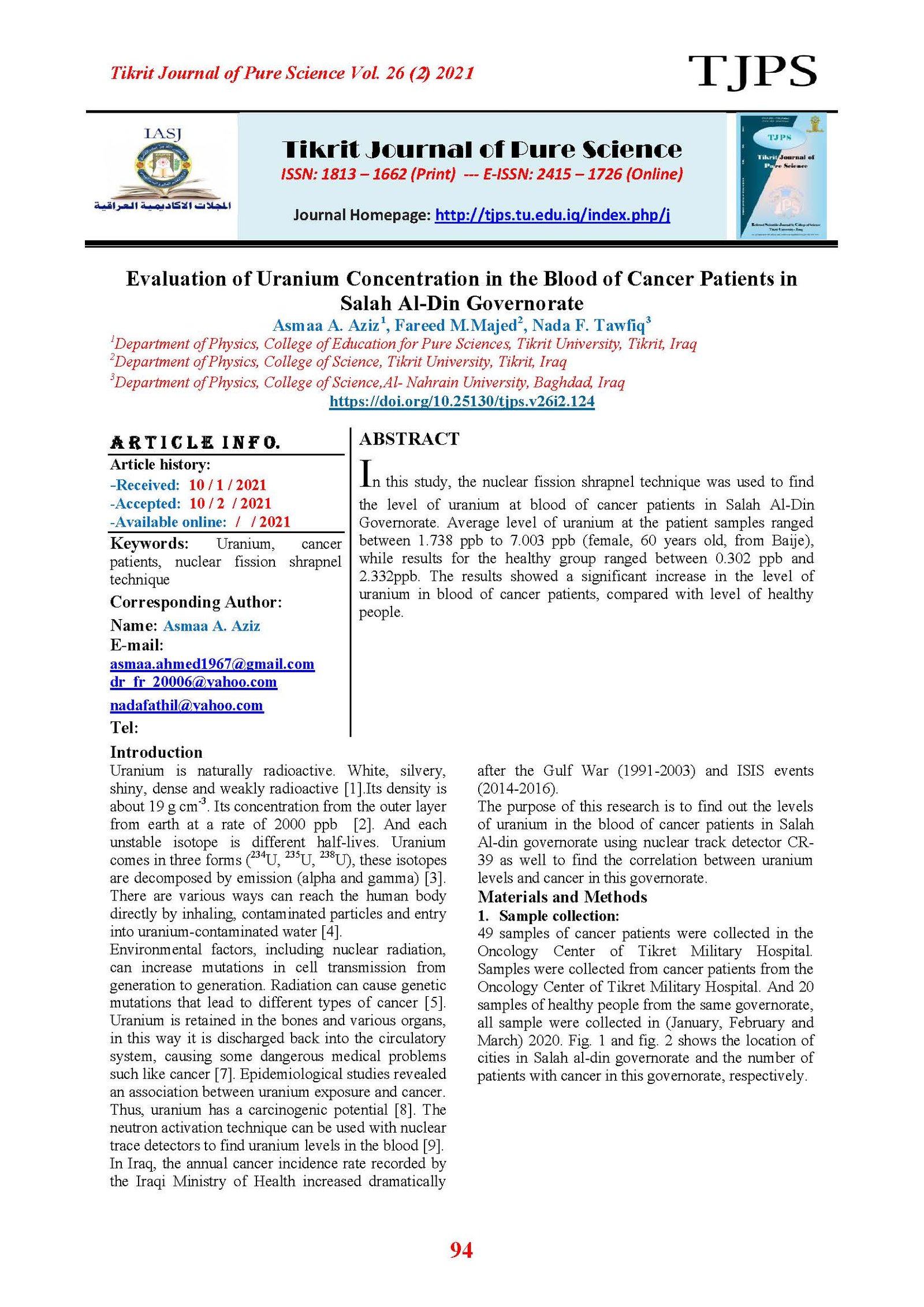Evaluation of Uranium Concentration in the Blood of Cancer Patients in Salah Al-Din Governorate
Main Article Content
Abstract
In this study, the nuclear fission shrapnel technique was used to find the level of uranium at blood of cancer patients in Salah Al-Din Governorate. Average level of uranium at the patient samples ranged between 1.738 ppb to 7.003 ppb (female, 60 years old, from Baije), while results for the healthy group ranged between 0.302 ppb and 2.332ppb. The results showed a significant increase in the level of uranium in blood of cancer patients, compared with level of healthy people.
Article Details

This work is licensed under a Creative Commons Attribution 4.0 International License.
Tikrit Journal of Pure Science is licensed under the Creative Commons Attribution 4.0 International License, which allows users to copy, create extracts, abstracts, and new works from the article, alter and revise the article, and make commercial use of the article (including reuse and/or resale of the article by commercial entities), provided the user gives appropriate credit (with a link to the formal publication through the relevant DOI), provides a link to the license, indicates if changes were made, and the licensor is not represented as endorsing the use made of the work. The authors hold the copyright for their published work on the Tikrit J. Pure Sci. website, while Tikrit J. Pure Sci. is responsible for appreciate citation of their work, which is released under CC-BY-4.0, enabling the unrestricted use, distribution, and reproduction of an article in any medium, provided that the original work is properly cited.
References
[1] Al-Rubaii, N.( 2004) ., Radiation Study of Selected Biological Samples (Doctoral dissertation, Ph. D. Thesis, College of Science, University of Al-Mustansiriyah).
[2] Morss, L.R.; Edelstein, N.M.; Fuger, J.; eds. (2006). The Chemistry of the Actinide and Transactinide Elements (3rd ed.). Netherlands: Springer.
[3] Al-Jobouri, A. F. S. (2012). Determination of Uranium Concentration in Human Urine for Selected Regions in Iraq Using Laser-Induced Kinetic Phosphorimetry and CR-39 Nuclear Track Detector. MSc. Thesis, College of Science, Al-Nahrain University.
[4] Favre-Réguillona A.; Lebuzitb G.; Muratb D.; Foosb J.; Mansourc C. and Drayed M. (2008).
Selective removal of dissolved uranium in drinking water by nanofiltrationm, Water Res. 42, 1160-1166.
[5] Coursey, J. S.; Schwab, D. J.; Tsai, J. J. and Dragoset, R. A. (2015). Atomic weights and isotopic compositions with relative atomic masses. NIST Physical Measurement Laboratory.
[6] Banks, D.; Royest, O.; Strand, T. and Skarphagen, H. (1995). Radioelement (U, Th, Rn) concentration in Norwegian bedrock waters, J. Environ Geol. (25), 165-180.
[7] Bersina, I.G.; Brandut, R.; Vater, P. K. and Hinke, M. (1995). Fission tracks autoradiography as ameans to investigate for their contamination with natural and technogenic uranium, J. Radiation Measurements. (24) 277-285.
[8] Tawfiq, N.F.; Ali, L.T.; Al-jobbery H.A. (2012). Uranium concentration in human blood for some governorates in Iraq using CR-39 track detector, J. Radioanal Nuc Chem. (295), 671-674.
[9] Abed, M.M., (2019). Calculation of Uranium Concentrations in Blood and Urine Samples of Renal Failure Patients in Al-Muthanna Governorate, Ph.D, College of Education for pure Sciences Ibn Al-Haitham, University of Baghdad.
[10] Fox SI, (2003).Human physiology. McGraw-Hill Science, New York.
[11] HASSAN, A.A. (2015). STUDY OF URANIUM CONCENTRATION AND TOXIC ELEMENTS IN BIOLOGICAL SAMPLES OF CANCEROUS PATIENTS IN SOUTHERN IRAQ, Ph.D, UNIVERSITI SAINS MALAYSIA,
